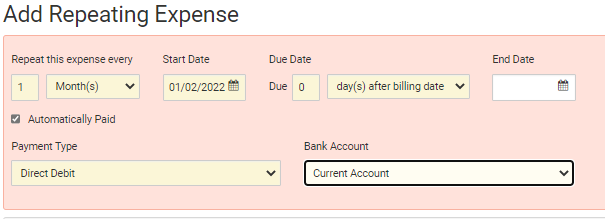Adding Repeating Expenses
If you have direct debits and standing orders, it makes sense to get the software to add these expenses for you, rather than adding them every time they come up. Mortgages and loans should be entered in to the Finance Manager, but other recurring expenses can be added to Property Manager > Expenses. This guide goes through the process.
In Property Manager > Expenses, click Add Repeating Expense.
The red box at the top allows you to tell the software how often the expense occurs. The bottom section allows you to record the expense itself. Use the Every field do tell the software how often the expense goes out, so if it is monthly, select Every 1 month. If the expense is quarterly, select Every 3 months. If the expense is paid every other week, select Every 2 weeks and so on.
Set the Start Date to be the date of the first expense you want to enter in to the database. The software will then record all of the next ones after this date using the frequency you just set.
Due Date is almost always 0 Days after payment start date. If your expenses are typically due on a different date, you can use this to change it.
Set an End Date if the expense has a limited duration, otherwise leave this blank.

Now on to the actual expense. The process here is the same as setting up a normal expense. Set up the Supplier, Expense Item, Description, Account and Property.
Press Save to complete the process and make the software write the expenses each time. If you have set it up correctly, the bank statements should easily match with the expenses, making the reconciliation process much easier. Once you press Save, the Next Due Date will update to the next payment date as it will have written the other payments up to the current date.
Editing a repeating expense
If the amount to be paid changes at any time, head to the Repeating tab of the Property Manager > Expenses page and edit the rules of the expense. You can set the Next Due Date back to an earlier date, however be aware that the software will write a new set of expenses alongside the existing ones, so you will need to manually delete the duplicated expenses once you have got the correct ones in.
Ending a repeating expense
Once the repeating expense has finished, there are two ways to stop it in the software.
Set an End Date so that the expense will stop being written once that date is reached. Or
Delete the repeating expense. This will stop the software from writing any more expenses for this entry.
Customer support service by UserEcho

